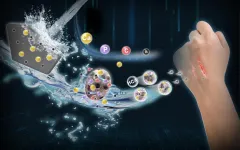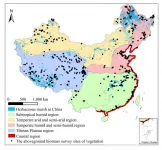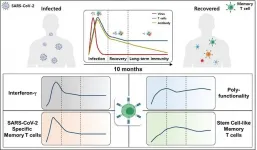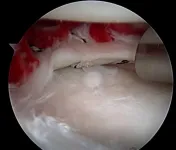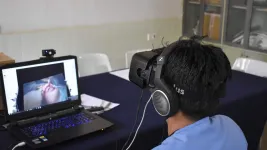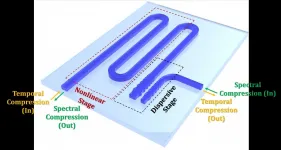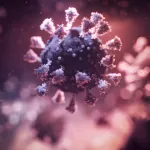(Press-News.org) A new nanotechnology development by an international research team led by Tel Aviv University researchers will make it possible to generate electric currents and voltage within the human body through the activation of various organs (mechanical force). The researchers explain that the development involves a new and very strong biological material, similar to collagen, which is non-toxic and causes no harm to the body's tissues. The researchers believe that this new nanotechnology has many potential applications in medicine, including harvesting clean energy to operate devices implanted in the body (such as pacemakers) through the body's natural movements, eliminating the need for batteries.
The study was led by Prof. Ehud Gazit of the Shmunis School of Biomedicine and Cancer Research at the Wise Faculty of Life Sciences, the Department of Materials Science and Engineering at the Fleischman Faculty of Engineering and the Center for Nanoscience and Nanotechnology, along with his lab team, Dr. Santu Bera and Dr. Wei Ji.
Also taking part in the study were researchers from the Weizmann Institute and a number of research institutes in Ireland, China and Australia. As a result of their findings, the researchers received two ERC-POC grants aimed at using the scientific research from the ERC grant that Gazit had previously won for applied technology. The research was published in the prestigious journal Nature Communications.
Prof. Gazit, who is also Founding Director of the BLAVATNIK CENTER for Drug Discovery, explains: "Collagen is the most prevalent protein in the human body, constituting about 30% of all of the proteins in our body. It is a biological material with a helical structure and a variety of important physical properties, such as mechanical strength and flexibility, which are useful in many applications. However, because the collagen molecule itself is large and complex, researchers have long been looking for a minimalistic, short and simple molecule that is based on collagen and exhibits similar properties. About a year and a half ago, in the journal Nature Materials, our group published a study in which we used nanotechnological means to engineer a new biological material that meets these requirements. It is a tripeptide - a very short molecule called Hyp-Phe-Phe consisting of only three amino acids - capable of a simple process of self-assembly of forming a collagen-like helical structure that is flexible and boasts a strength similar to that of the metal titanium. In the present study, we sought to examine whether the new material we developed bears another feature that characterizes collagen - piezoelectricity. Piezoelectricity is the ability of a material to generate electric currents and voltage as a result of the application of mechanical force, or vice versa, to create a mechanical force as the result of exposure to an electric field."
In the study, the researchers created nanometric structures of the engineered material, and with the help of advanced nanotechnology tools, applied mechanical pressure on them. The experiment revealed that the material does indeed produce electric currents and voltage as a result of the pressure. Moreover, tiny structures of only hundreds of nanometers demonstrated one of the highest levels of piezoelectric ability ever discovered, comparable or superior to that of the piezoelectric materials commonly found in today's market (most of which contain lead and are therefore not suitable for medical applications).
According to the researchers, the discovery of piezoelectricity of this magnitude in a nanometric material is of great significance, as it demonstrates the ability of the engineered material to serve as a kind of tiny motor for very small devices. Next, the researchers plan to apply crystallography and computational quantum mechanical methods (density functional theory) in order to gain an in-depth understanding of the material's piezoelectric behavior and thereby enable the accurate engineering of crystals for the building of biomedical devices.
Prof. Gazit adds: "Most of the piezoelectric materials that we know of today are toxic lead-based materials, or polymers, meaning they are not environmentally and human body-friendly. Our new material, however, is completely biological, and therefore suitable for uses within the body. For example, a device made from this material may replace a battery that supplies energy to implants like pacemakers, though it should be replaced from time to time. Body movements - like heartbeats, jaw movements, bowel movements, or any other movement that occurs in the body on a regular basis - will charge the device with electricity, which will continuously activate the implant."
Now, as part of their continuing research, the researchers are seeking to understand the molecular mechanisms of the engineered material with the goal of realizing its immense potential and turning this scientific discovery into applied technology. At this stage, the focus is on the development of medical devices, but Prof. Gazit emphasizes that "environmentally friendly piezoelectric materials, such as the one we have developed, have tremendous potential in a wide range of areas because they produce green energy using mechanical force that is being used anyway. For example, a car driving down the street can turn on the streetlights. These materials may also replace lead-containing piezoelectric materials that are currently in widespread use, but that raise concerns about the leakage of toxic metal into the environment."
INFORMATION:
Links to the original articles:
https://www.nature.com/articles/s41467-021-22895-6
https://www.nature.com/articles/s41563-019-0343-2
Recently, with the help of a steady-state strong magnetic field experimental device, scientists constructed nano-scale borate bioactive glass (Nano-HCA@BG), which can effectively reduce the biological toxicity of borate bioglass, improve the biocompatibility of the glass, and promote the effect of borate bioglass on skin repair.
Prof. WANG Junfeng from the Hefei Institutes of Physical Science (HFIPS) of the Chinese Academy of Sciences (CAS), collaborating with Prof. ZHANG Teng from Fuzhou University in this study, said, "it is expected to become the next generation of skin wound repair dressings." Related research was published in Chemical Engineering Journal.
Borate bioglass is a glass with boron element (B) as the glass network matrix. With good dopability and degradability, it ...
Sleep deprivation - from lifestyle choices, pandemic stress, or late-night computer study - can quickly lead to loss of energy and function during the day and even feelings of anger and depression, an Australian sleep institute study has shown.
The study, led by Flinders University, asked 34 health teenagers (20 males) aged between 15 and 17 to spent 10 days and nine nights in a specially designed sleep centre.
They were allocated to one of three sleep 'doses' for five consecutive nights- from five hours, 7.5 hours, or 10 hours in bed per night - with two baseline and two 'recovery' nights of up to 10 hours' time in bed.
Their mood was measured every three hours after waking up to assess responses to feelings such as 'depressed', 'afraid', 'angry', 'confused', ...
Wetland, forest, and ocean are the three largest ecosystems in the world. Although the area of wetland ecosystem accounts for only 4-6% of the total land area, the carbon reserves of wetland ecosystem accounts for 12-24% of the global land carbon reserves. Under the background of global climate change, the research on carbon sequestration of wetland has become an important subject of global carbon cycle research.
The area of marshes in China ranks third in the world, and herbaceous marsh is the most widely distributed among all the types of marshes. As an important quality parameter of marsh ecosystem, aboveground biomass of vegetation is a crucial index estimating the carbon storage of marsh vegetation, and the basis for studying ...
A KAIST immunology research team found that most convalescent patients of COVID-19 develop and maintain T cell memory for over 10 months regardless of the severity of their symptoms. In addition, memory T cells proliferate rapidly after encountering their cognate antigen and accomplish their multifunctional roles. This study provides new insights for effective vaccine strategies against COVID-19, considering the self-renewal capacity and multipotency of memory T cells.
COVID-19 is a disease caused by severe acute respiratory syndrome coronavirus-2 (SARS-CoV-2) infection. When patients recover from COVID-19, SARS-CoV-2-specific adaptive immune memory is developed. The adaptive immune system consists ...
While this isn't the fountain of youth, scientists may have improved healing in our joints - even in areas that become weaker as we grow older. The meniscus is a durable, yet flexible tissue found in joints like our wrist and knees that helps them absorb shock during movement. Occasionally tears can occur in the meniscus due an awkward movement or structural weakness from old age. When we are young, there is plenty of blood flowing to this area allowing for quick healing, but as we get older, the meniscus receives less and less blood - with the inner most area becoming ...
An international team including Lancaster University researchers has created a strategy for understanding the evolution of the COVID-19 pandemic throughout the African continent.
Their COVID-19 surveillance strategy will improve the ability of African countries to interpret the complex data available to them during the pandemic.
Professor Peter Diggle, Dr Chris Jewell and Dr Claudio Fronterre from the Centre for Health Informatics, Computing and Statistics (CHICAS) at Lancaster Medical School worked with colleagues in the USA, Uganda and Switzerland to create a data-driven disease surveillance framework to track and predict ...
Cleft lip and palate is one of the most common congenital malformations. Its causes are mainly genetic. However, it is still largely unknown exactly which genes are affected. A new international study led by the University of Bonn now provides new insights. The results are published in the journal Human Genetics and Genomics Advances, but are already available online.
The researchers from the Institute of Human Genetics at the University Hospital Bonn combined various data sources in their work. In the course of their research, they discovered five new regions in the human genome in which variations in the DNA sequence are associated with an ...
A new report that could help improve how immersive technologies such as Virtual Reality (VR) and Augmented Reality (AR) are used in healthcare education and training has been published with significant input from the University of Huddersfield.
Professor David Peebles, Director of the University's Centre for Cognition and Neuroscience, and Huddersfield PhD graduate Matthew Pears contributed to the report - 'Immersive technologies in healthcare training and education: Three principles for progress' - recently published by the University of Leeds with input from range of academics, technologists and health professionals.
The principles have also been expanded upon in a letter to the prestigious journal BMJ ...
A train carrying cargo has finite space. The amount of cargo that can be carried onboard is limited by the size of the cargo and the capacity of the train. Analogously, the amount of time taken up by an optical signal limits the amount of data that can be carried. Temporally shorter signals allow more data to be squeezed into a given time duration, in a method called optical time division multiplexing. Photonics researchers have recently succeeded in squeezing light in time by 11 times. The developed temporal compression system allows an equivalent increase in the number of bits transmitted by light ...
A new international study has found that the key properties of the spikes of SARS-CoV-2 virus which causes COVID-19 are consistent with those of several laboratory-developed protein spikes, designed to mimic the infectious virus.
A central component in designing serological tests and vaccines to protect against COVID-19 is the manufacture of protein "spikes". These recombinant spikes closely mimic those sticking out of surface of the infectious virus and trigger the body's immune system into action.
Laboratory manufactured spikes are also used for serological testing (also referred to as antibody testing) and as research reagents. The findings show how that viral spike manufactured through different methods in laboratories across the globe ...

